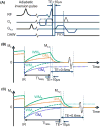Inversion recovery ultrashort echo time imaging of ultrashort T2 tissue components in ovine brain at 3 T: a sequential D2 O exchange study
- PMID: 28731616
- PMCID: PMC5617132
- DOI: 10.1002/nbm.3767
Inversion recovery ultrashort echo time imaging of ultrashort T2 tissue components in ovine brain at 3 T: a sequential D2 O exchange study
Abstract
Inversion recovery ultrashort echo time (IR-UTE) imaging holds the potential to directly characterize MR signals from ultrashort T2 tissue components (STCs), such as collagen in cartilage and myelin in brain. The application of IR-UTE for myelin imaging has been challenging because of the high water content in brain and the possibility that the ultrashort T2 * signals are contaminated by water protons, including those associated with myelin sheaths. This study investigated such a possibility in an ovine brain D2 O exchange model and explored the potential of IR-UTE imaging for the quantification of ultrashort T2 * signals in both white and gray matter at 3 T. Six specimens were examined before and after sequential immersion in 99.9% D2 O. Long T2 MR signals were measured using a clinical proton density-weighted fast spin echo (PD-FSE) sequence. IR-UTE images were first acquired with different inversion times to determine the optimal inversion time to null the long T2 signals (TInull ). Then, at this TInull , images with echo times (TEs) of 0.01-4 ms were acquired to measure the T2 * values of STCs. The PD-FSE signal dropped to near zero after 24 h of immersion in D2 O. A wide range of TInull values were used at different time points (240-330 ms for white matter and 320-350 ms for gray matter at TR = 1000 ms) because the T1 values of the long T2 tissue components changed significantly. The T2 * values of STCs were 200-300 μs in both white and gray matter (comparable with the values obtained from myelin powder and its mixture with D2 O or H2 O), and showed minimal changes after sequential immersion. The ultrashort T2 * signals seen on IR-UTE images are unlikely to be from water protons as they are exchangeable with deuterons in D2 O. The source is more likely to be myelin itself in white matter, and might also be associated with other membranous structures in gray matter.
Keywords: T2*; gray matter; inversion recovery ultrashort echo time imaging; inversion time; myelin; white matter.
Copyright © 2017 John Wiley & Sons, Ltd.
Figures






Similar articles
-
Inversion recovery ultrashort echo time magnetic resonance imaging: A method for simultaneous direct detection of myelin and high signal demonstration of iron deposition in the brain - A feasibility study.Magn Reson Imaging. 2017 May;38:87-94. doi: 10.1016/j.mri.2016.12.025. Epub 2016 Dec 28. Magn Reson Imaging. 2017. PMID: 28038965 Free PMC article.
-
Whole-Brain Myelin Imaging Using 3D Double-Echo Sliding Inversion Recovery Ultrashort Echo Time (DESIRE UTE) MRI.Radiology. 2020 Feb;294(2):362-374. doi: 10.1148/radiol.2019190911. Epub 2019 Nov 19. Radiology. 2020. PMID: 31746689 Free PMC article.
-
Yet more evidence that myelin protons can be directly imaged with UTE sequences on a clinical 3T scanner: Bicomponent T2* analysis of native and deuterated ovine brain specimens.Magn Reson Med. 2018 Aug;80(2):538-547. doi: 10.1002/mrm.27052. Epub 2017 Dec 21. Magn Reson Med. 2018. PMID: 29271083 Free PMC article.
-
Use of Multiplied, Added, Subtracted and/or FiTted Inversion Recovery (MASTIR) pulse sequences.Quant Imaging Med Surg. 2020 Jun;10(6):1334-1369. doi: 10.21037/qims-20-568. Quant Imaging Med Surg. 2020. PMID: 32550142 Free PMC article. Review.
-
New options for increasing the sensitivity, specificity and scope of synergistic contrast magnetic resonance imaging (scMRI) using Multiplied, Added, Subtracted and/or FiTted (MASTIR) pulse sequences.Quant Imaging Med Surg. 2020 Oct;10(10):2030-2065. doi: 10.21037/qims-20-795. Quant Imaging Med Surg. 2020. PMID: 33014733 Free PMC article. Review.
Cited by
-
Mapping the myelin bilayer with short-T2 MRI: Methods validation and reference data for healthy human brain.Magn Reson Med. 2023 Feb;89(2):665-677. doi: 10.1002/mrm.29481. Epub 2022 Oct 17. Magn Reson Med. 2023. PMID: 36253953 Free PMC article.
-
Longitudinal evaluation of demyelinated lesions in a multiple sclerosis model using ultrashort echo time magnetization transfer (UTE-MT) imaging.Neuroimage. 2020 Mar;208:116415. doi: 10.1016/j.neuroimage.2019.116415. Epub 2019 Dec 4. Neuroimage. 2020. PMID: 31811900 Free PMC article.
-
Making the invisible visible-ultrashort echo time magnetic resonance imaging: Technical developments and applications.Appl Phys Rev. 2022 Dec;9(4):041303. doi: 10.1063/5.0086459. Appl Phys Rev. 2022. PMID: 36467869 Free PMC article. Review.
-
Brain ultrashort T2 component imaging using a short TR adiabatic inversion recovery prepared dual-echo ultrashort TE sequence with complex echo subtraction (STAIR-dUTE-ES).J Magn Reson. 2021 Feb;323:106898. doi: 10.1016/j.jmr.2020.106898. Epub 2020 Dec 28. J Magn Reson. 2021. PMID: 33429170 Free PMC article.
-
Ultrashort echo time (UTE) magnetic resonance imaging of myelin: technical developments and challenges.Quant Imaging Med Surg. 2020 Jun;10(6):1186-1203. doi: 10.21037/qims-20-541. Quant Imaging Med Surg. 2020. PMID: 32550129 Free PMC article. No abstract available.
References
-
- Koch-Henriksen N, Sorensen PS. The changing demographic pattern of multiple sclerosis epidemiology. Lancet Neurol. 2010;9(5):520–532. - PubMed
-
- Deoni SCL, Rutt BK, Arun T, Pierpaoli C, Jones DK. Gleaning Multicomponent T(1) and T(2) Information From Steady-State Imaging Data. Magn Reson Med. 2008;60(6):1372–1387. - PubMed
MeSH terms
Substances
Grants and funding
LinkOut - more resources
Full Text Sources
Other Literature Sources
Medical

